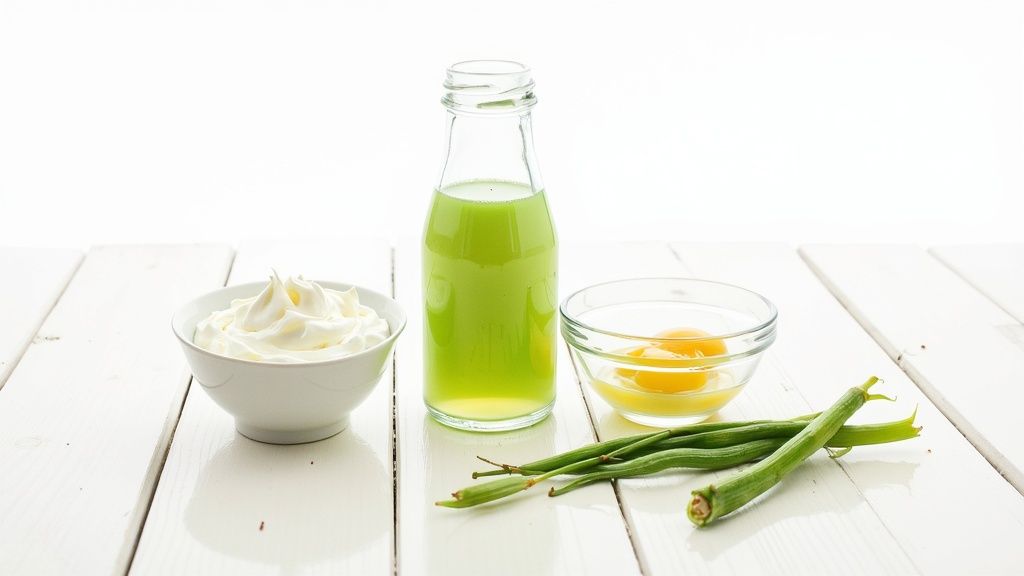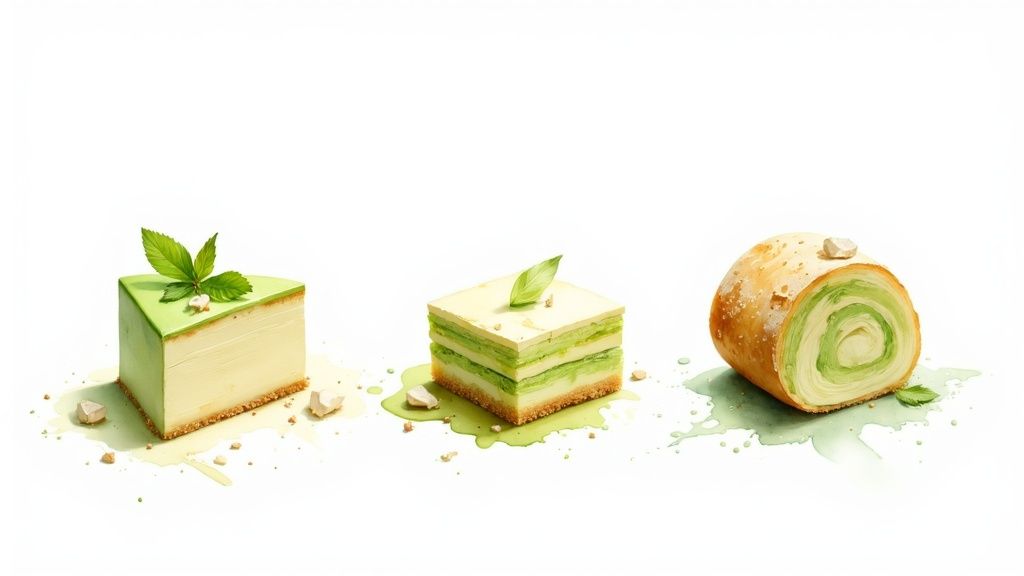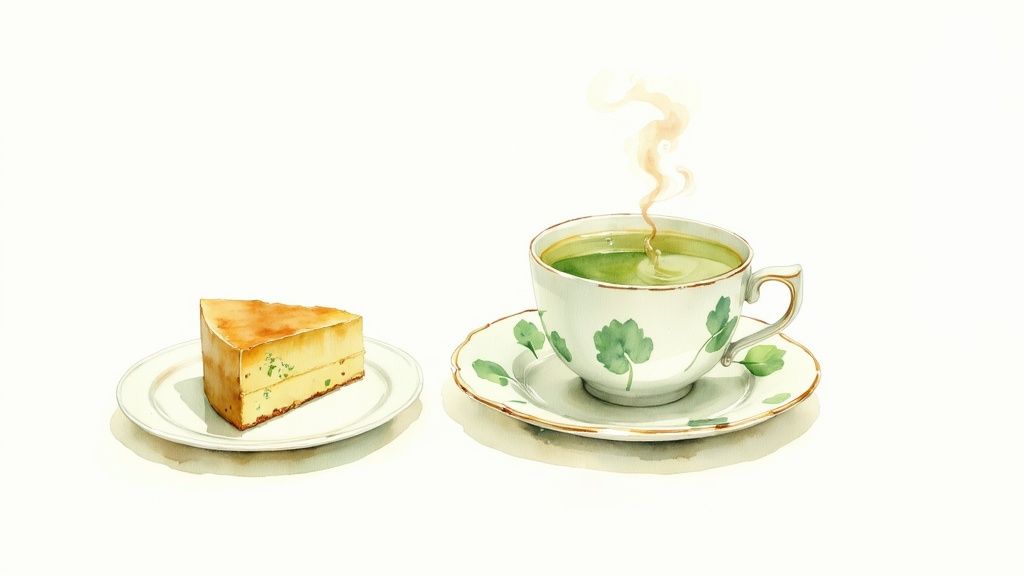Your Ultimate Guide to Pandan Cake
Ever seen a bright green, fluffy cake and wondered what it was? You probably just met a pandan cake. It's a light chiffon cake from Southeast Asia, getting its colour and flavour from pandan leaf juice.
Imagine a mix of vanilla and coconut with a unique, grassy scent. It's unlike anything else.
What Is a Pandan Cake?

So what's the deal with this green dessert? Its origin is a blend of European baking and Southeast Asian ingredients. The idea started when colonial settlers introduced sponge cake recipes to the region.
Local bakers adapted these recipes, using the fragrant pandan leaf instead of typical flavourings. The result was a unique cake with a vibrant colour. It became a hit in Indonesia, Singapore, and Malaysia, and you can learn about its rich culinary history.
The Defining Features
What makes a pandan cake so special? A few key things set it apart from other desserts.
- Flavour Profile: The taste is subtle but distinct. People call it the "vanilla of Southeast Asia," with notes of coconut and a fresh, botanical aroma.
- Texture: A proper pandan cake is a chiffon cake. This means it's light, soft, and moist with a springy, cloud-like crumb.
- Appearance: The natural green colour is iconic. The best versions skip artificial colouring for a beautiful, earthy green.
The magic of pandan cake is its balance. It's sweet without being overpowering, and its airy texture feels light.
This cake is a cultural icon. In 2017, CNN named it the national cake of Singapore and Malaysia. Its true origin remains a topic of debate.
No matter where it's from, the appeal of a great pandan cake is universal.
The Core Ingredients of a Great Pandan Cake

Wonder what gives a pandan cake its incredible flavour and fluffy texture? It comes down to a few key ingredients working together. Getting these right separates a decent cake from an unforgettable one.
The magic starts with quality ingredients. You can't fake authenticity here.
The Heart of the Flavour: Pandan and Coconut
The non-negotiable star is fresh pandan extract. There is no substitute for the genuine taste. The best flavour comes from blending fresh pandan leaves with water, then straining it for a fragrant juice.
This natural extract provides both the signature aroma and green colour. Bottled essences often contain artificial additives and fail to replicate the complex notes of the real thing.
Coconut milk is pandan's essential partner. It adds a creamy richness that balances the light, herbal flavour of the pandan. Full-fat coconut milk is crucial for creating the moist, tender crumb.
The Secret to the Lightness: The Chiffon Method
A true pandan cake is a chiffon cake. This baking method gives it a famously light and airy structure. The technique relies on separating the eggs.
The process involves two separate mixtures:
- The Yolk Batter: Egg yolks are mixed with flour, sugar, oil, pandan juice, and coconut milk to create a rich base.
- The Meringue: Egg whites are whipped with sugar to form stiff, glossy peaks, trapping air that acts as the leavening agent.
These two mixtures are then folded together. The air bubbles in the meringue make the cake rise in the oven, creating its signature cloud-like texture. This step requires a gentle hand to avoid deflating the air.
The chiffon method is the structural backbone of a great pandan cake. It’s about building a delicate, air-filled foundation that makes the cake impossibly light.
If you're baking your own cake and want to reduce sugar, exploring healthy sugar alternatives for baking can provide great options. The right ingredients create that perfect balance of sweetness and aroma.
Why Is Pandan Cake Suddenly Everywhere in Australia?
Have you noticed a green cake in Australian cafes and bakeries lately? You're not imagining it. Pandan cake is moving from a specialty treat to the mainstream, showing how Australia's food culture is evolving.
As our cities become more diverse, so do our palates. We're looking for authentic global flavours beyond the usual chocolate or vanilla. Pandan cake offers something new and exciting.
Its unique flavour and light, fluffy texture have resonated with people. It’s a refreshing option for anyone who wants a dessert that isn't too heavy or sweet.
The Cultural Shift on Our Plates
The rise of the pandan cake is a story about community and flavour. As Southeast Asian communities settled in Australia, they brought their recipes with them. What started as a taste of home has crossed over into the wider Aussie food scene.
The numbers support this. Cities with large Southeast Asian populations like Sydney and Melbourne are pandan hotspots. Market surveys from 2023 found that pandan-flavoured goods make up about 12% of Southeast Asian-inspired bakery sales in Australia, with the market seeing 15% annual growth since 2018. If you want more on this cultural exchange, you can find more details about its global journey.
The growing love for pandan cake is more than a food trend. It’s proof that Australia’s palate is broadening, embracing authentic tastes from diverse communities.
Bakeries are paying attention. Some spots in Melbourne report selling thousands of these cakes annually. You can experience pandan cakes in Melbourne to see what the fuss is about.
What’s the Big Deal?
Why has this cake captured our attention? It comes down to a few things Aussies appreciate in a good dessert.
- A Unique Taste: The flavour is complex—a little nutty, a bit like vanilla, with a subtle grassy freshness.
- A Lighter Option: Many people want a sweet treat that doesn't feel heavy. The airy, chiffon texture is the perfect answer.
- It’s Pretty: The natural, vivid green colour is stunning. It’s an eye-catching dessert that looks as good as it tastes.
This green cake is no longer a niche find. It’s becoming a favourite on menus across the country, proving how a simple, delicious pandan cake can bring people together.
Exploring Different Pandan Cake Styles

You might think a pandan cake is just one thing. But that’s like saying all bread is the same. The classic chiffon style is famous for its light texture, but that’s just the start.
Different parts of Southeast Asia have unique variations. Each offers a different experience, from light to dense and buttery. Knowing the styles helps you find your perfect pandan dessert.
The Classic Pandan Chiffon Cake
This is the one most people know. Its signature feature is incredible lightness. Made with the chiffon method, it relies on whipped egg whites for an airy, springy crumb.
The flavour is delicate, focusing on the pandan with a hint of coconut milk. It’s almost never frosted because that would weigh it down. This is the purist’s pandan cake.
Pandan Butter Cake
If you prefer something with more substance, try the pandan butter cake. It uses rich butter instead of the light oil found in chiffon cakes. The result is a denser, moister, and more crumbly texture, like a pound cake infused with pandan.
This style has a richer flavour profile. The buttery notes complement the pandan, making it a more substantial treat.
Layered and Filled Pandan Cakes
This is where things get interesting. Modern bakeries create complex, layered versions with new textures and flavours. These cakes often alternate layers of pandan sponge with delicious fillings.
Some popular combinations include:
- Kaya Layer Cake: Features layers of pandan cake with rich kaya, a traditional coconut and egg jam.
- Coconut Cream Cake: Layers pandan sponge with a light coconut whipped cream, sometimes with shreds of fresh young coconut.
- Pandan Gula Melaka Cake: Pairs pandan with the caramel-like flavour of gula melaka (palm sugar), often with desiccated coconut on top.
Exploring layered cakes is a great way to experience how well pandan pairs with other classic Southeast Asian flavours. Each layer adds a new dimension.
One great example is the Pandan Layer Cake, offering a balance of fluffy sponge and creamy filling. To try an expert version, check out this delicious pandan layer cake loaf.
Inventive bakers have also adapted the flavour into swiss rolls, cupcakes, and cheesecakes. Pandan's versatility means it can be used in almost any dessert.
This quick guide covers some common variations.
Common Pandan Cake Variations
| Cake Variation | Primary Texture | Key Flavour Notes | Best Paired With |
|---|---|---|---|
| Pandan Chiffon Cake | Light, airy, spongy | Pure pandan, subtle coconut | A simple cup of tea or coffee |
| Pandan Butter Cake | Dense, moist, crumbly | Rich butter, fragrant pandan | On its own as a rich afternoon tea treat |
| Pandan Layer Cake | Soft sponge with creamy layers | Pandan, coconut, sometimes kaya | A glass of iced milk tea |
| Pandan Gula Melaka Cake | Spongy and sticky | Pandan, deep caramel, smoky palm sugar | A scoop of vanilla or coconut ice cream |
This table shows the different experiences each style offers. This variety ensures there's a pandan cake for every preference.
How to Spot a Genuinely Good Pandan Cake
So you're ready to try your first pandan cake. How can you be sure you're getting the real deal? A few simple tells separate an incredible cake from a disappointing one.
Start with your eyes. A proper pandan cake should have a natural, leafy green colour. A neon green cake is a major red flag for artificial colouring.
Look, Smell, and Touch
The best cakes get their colour directly from fresh pandan leaves, giving them a muted, earthy hue. Next, trust your nose. An authentic pandan cake has a fragrant, sweet, and slightly grassy aroma.
If it smells overly sweet or has no scent, it was likely made with bottled essence. Finally, check the texture. A great pandan chiffon cake is famous for its bounce.
- Visual Check: Look for a springy, open crumb full of tiny air pockets. This indicates a light, airy chiffon texture.
- Touch Test: It should feel incredibly soft and pillowy. Avoid anything that looks dense, heavy, or oily.
The gold standard is a cake that is unbelievably light yet still moist. It should melt in your mouth, not feel dry or heavy.
What Goes into a Quality Cake
The quality of a pandan cake comes down to two things: ingredients and skill. Freshly squeezed pandan juice provides a complex aroma that artificial extracts can't replicate. Full-fat coconut milk is also key for a perfectly moist crumb.
The baker’s technique is crucial. Properly whipping egg whites into a stable meringue and gently folding it into the batter creates the signature cloud-like texture. For consistent results, bakeries need to choose the right commercial ovens for bakery success.
Spotting a great pandan cake is about trusting your senses. Look for the natural colour, authentic aroma, and light texture. When you find a cake that ticks these boxes, you’ll understand what makes an authentic pandan cake so special.
How to Best Serve and Enjoy Your Pandan Cake

You have a perfect pandan cake. What’s the best way to enjoy it? The good news is its delicate flavour and fluffy texture are the main event, so you don’t need to do much.
This cake is designed to be enjoyed simply. Its light, aromatic profile stands on its own, so skip heavy frostings or thick creams. They only get in the way of the unique pandan and coconut notes.
Perfect Pairings for Pandan
The right drink can elevate the experience. You want something that complements the cake's flavour, not competes with it. A hot beverage is a classic choice, as the warmth contrasts with the soft, room-temperature cake.
Here are a few great options:
- Black Tea: A simple cup of black tea cuts through the subtle sweetness.
- Green Tea: The grassy notes in green tea echo the pandan's aroma.
- Light-Roast Coffee: A coffee with brighter, floral notes complements the cake's delicate taste.
- Teh Tarik: For a traditional pairing, try teh tarik (pulled milk tea). Its creamy, sweet profile is a classic companion.
Serving It Right
Serving a pandan cake is straightforward. It’s best enjoyed at room temperature to allow its full flavour and aroma to come through. If it's been in the fridge, let it sit on the counter for about 30 minutes before slicing.
The core principle is simplicity. The cake’s flavour and texture are the stars, so let them perform without distractions. Just slice and serve.
This simple approach is the best way to appreciate what makes an authentic pandan cake so special. You can explore a selection of pandan cakes and cupcakes available in Melbourne to try these pairings.
Whether for a special occasion or a simple treat, you now know how to get the most from your pandan cake.
Your Pandan Cake Questions, Answered
Have a few questions about your pandan cake? Perfect. You're not the first to wonder about the best way to care for this delicious treat. Let's get those common queries sorted out.
How Should I Store My Pandan Cake?
Proper storage keeps your pandan cake fresh and fluffy. For the best taste, keep it in an airtight container at room temperature if you plan to eat it within 3 days. Chilling can make a chiffon cake dense and dry.
If you need it to last longer, you can refrigerate it for up to a week. Make sure it’s sealed tightly to avoid fridge smells. Let it sit out for about 30 minutes before serving to return it to room temperature.
Can I Freeze Pandan Cake?
Yes, you can. Freezing is a great way to save some for later.
Wrap the cake in a double layer of cling wrap, then add a layer of aluminium foil. This prevents freezer burn. It will keep in the freezer for up to 3 months. Thaw it on the counter for a few hours when you're ready to eat it.
Pro-tip: Freeze individual slices instead of the whole cake. It’s easier to grab one or two pieces whenever you want.
Is Pandan Cake Gluten-Free?
Traditionally, the answer is no. A classic pandan chiffon cake uses wheat flour for its light crumb.
The good news is that many modern bakeries offer gluten-free versions. These recipes use alternatives like rice flour or a special gluten-free blend. Always double-check with the bakery about their ingredients if you have a gluten sensitivity.
What Makes the Cake Green?
That soft green colour should only come from one place: fresh pandan leaves. The authentic process involves blending the leaves with water to create a natural extract. This gives the cake its unmistakable flavour and subtle hue.
A neon green cake is a giveaway that artificial colouring and flavouring were used. A true pandan cake will always have a much more natural, earthy shade of green.
Ready to taste an authentic pandan cake for yourself? Amour Desserts handcrafts every cake using only the freshest ingredients. Order yours today for delivery across Melbourne.
